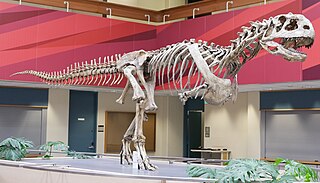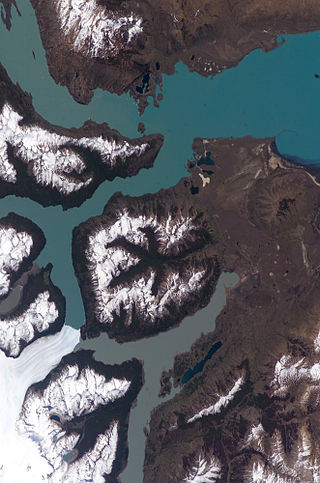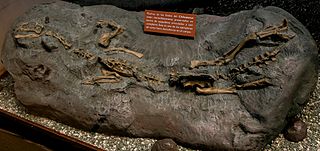Related Research Articles

Abelisauridae is a family of ceratosaurian theropod dinosaurs. Abelisaurids thrived during the Cretaceous period, on the ancient southern supercontinent of Gondwana, and today their fossil remains are found on the modern continents of Africa and South America, as well as on the Indian subcontinent and the island of Madagascar. Isolated teeth were found in the Late Jurassic of Portugal, and the Late Cretaceous genera Tarascosaurus, Arcovenator and Caletodraco have been described in France. Abelisaurids possibly first appeared during the Jurassic period based on fossil records, and some genera survived until the end of the Mesozoic era, around 66 million years ago.

Megaraptor is a genus of large theropod dinosaur that lived in the ages of the Late Cretaceous. Its fossils have been discovered in the Patagonian Portezuelo Formation of Argentina, South America. Initially thought to have been a giant dromaeosaur-like coelurosaur, it was classified as a neovenatorid allosauroid in previous phylogenies, but more recent phylogeny and discoveries of related megaraptoran genera has placed it as either a basal tyrannosauroid or a basal coelurosaur with some studies still considering it a neovenatorid.
The Huincul Formation is a geologic formation of Late Cretaceous age of the Neuquén Basin that outcrops in the Mendoza, Río Negro and Neuquén Provinces of northern Patagonia, Argentina. It is the second formation in the Río Limay Subgroup, the oldest subgroup within the Neuquén Group. Formerly that subgroup was treated as a formation, and the Huincul Formation was known as the Huincul Member.

Guaibasauridae is a family of basal sauropodomorph dinosaurs, known from fossil remains of late Triassic period formations in Brazil, Argentina and India.

Orkoraptor is a genus of medium-sized megaraptoran theropod dinosaur from the late Cretaceous Period of Argentina. It is known from incomplete fossil remains including parts of the skull, teeth, tail vertebrae, and a partial tibia. The specialized teeth resemble those of some maniraptoriform theropods, namely the deinonychosaurs and compsognathids. This and other anatomical features led the authors who described it to suggest that it was a maniraptoran coelurosaur. However, subsequent studies found it to be a megaraptoran. Found in the Cerro Fortaleza Formation of Southern Patagonia, it is one of the southernmost carnivorous dinosaurs known from South America.

Megaraptora is a clade of carnivorous theropod dinosaurs with controversial relationships to other tetanuran theropods. Its derived members, the Megaraptoridae are noted for their large hand claws and powerfully-built forelimbs, which are usually reduced in size in other large theropods.

The Chorrillo Formation, also named as Chorillo Formation, is a Maastrichtian geologic formation in southern Patagonia, Argentina. The formation is more than 50 metres (160 ft) thick and underlies the Calafate Formation and rests on top of the La Irene Formation.

Austrocheirus is an extinct genus of theropod dinosaur that lived during the Late Cretaceous period. It was named and described by Martin Ezcurra, Federico Agnolin and Fernando Novas in 2010. It contains the type species Austrocheirus isasii. The generic name means "southern hand". The specific epithet honours discoverer and preparator Marcelo Pablo Isasi.

Chilesaurus is an extinct genus of herbivorous dinosaur. The type and only known species so far is Chilesaurus diegosuarezi. Chilesaurus lived between 148-147 million years ago (Mya) in the Late Jurassic period of Chile. Showing a combination of traits from theropods, ornithischians, and sauropodomorphs, this genus has far-reaching implications for the evolution of dinosaurs, such as whether the traditional saurischian-ornithischian split is superior or inferior to the proposed group Ornithoscelida.

This timeline of ceratosaur research is a chronological listing of events in the history of paleontology focused on the ceratosaurs, a group of relatively primitive, often horned, predatory theropod dinosaurs that became the apex predators of the southern hemisphere during the Late Cretaceous. The nature and taxonomic composition of the Ceratosauria has been controversial since the group was first distinguished in the late 19th century. In 1884 Othniel Charles Marsh described the new genus and species Ceratosaurus nasicornis from the Late Jurassic Morrison Formation of the western United States. He felt that it belonged in a new family that he called the Ceratosauridae. He created the new taxon Ceratosauria to include both the Ceratosauridae and the ostrich-like ornithomimids. The idea of the Ceratosauria was soon contested, however. Later that same decade both Lydekker and Marsh's hated rival Edward Drinker Cope argued that the taxon was invalid.

Taurovenator is a large carcharodontosaurid theropod from the late Cretaceous Huincul Formation of Argentina that lived during the Cenomanian age of the Late Cretaceous. It is monotypic, containing only one species, T. violantei.
Aoniraptor is a genus of possibly megaraptoran or bahariasaurid theropod dinosaur from the Late Cretaceous of Argentina.
Martín Daniel Ezcurra is an Argentine palaeontologist naming many extinct genera such as Aerotitan, Lophostropheus and Powellvenator.

The Toqui Formation is a geological formation in the Aysén Region of southern Chile. It has been dated to the Tithonian stage of the Late Jurassic by uranium–lead dating of zircons, providing ages between 148.7 ± 1.4 Ma and 147 ± 1.0 Ma. It consists of a sequence of clastic sedimentary sandstones and conglomerates, interbedded with volcanic tuffs and ignimbrite. The dinosaurs Chilesaurus and indeterminate diplodocids and the mesoeucrocodylian Burkesuchus are known from the formation. The formation was deposited in a fluvio-deltaic environment.
Isasicursor is a genus of elasmarian ornithopod from the Chorrillo Formation from Santa Cruz Province in Argentina. The type and only species is Isasicursor santacrucensis. It was a contemporary of the sauropod Nullotitan which was described in the same paper.

Overoraptor is an extinct genus of paravian theropod of uncertain affinities from the Late Cretaceous Huincul Formation of Argentinian Patagonia. The genus contains a single species, O. chimentoi, known from several bones of the hands, feet, and hips alongside some vertebrae.

Burkesuchus is an extinct genus of basal neosuchians from the Upper Jurassic (Tithonian)-aged Toqui Formation of southern Chile. The genus is currently represented by a single species B. mallingrandensis, named and described in 2021 on the basis of the holotype and additional referred specimens. Burkesuchus mallingrandensis was noticeably small being around an estimated 70 cm in length. The cranium is dorsoventrally depressed and transversely wide posteriorly and distinguished by a posteroventrally flexed wing-like squamosal. Burkesuchus was a small carnivore likely on invertebrates animals such as insects, crustaceans and may had feed on small aquatic vertebrates like fish. B. mallingrandensis did not have the ability to feed on large prey items or tear large chunks of meat like modern day crocodiles do. The holotype SQO.PV 17700, consist of a cervical neural arch, partial neurocranium, four dorsal vertebrae, right scapula, a right coracoid, right humerus, a ulna, left ischium, distal end of the right femur, one cervical and two dorsal osteoderms. The paratype SQO.PV 17701 fossil remains consist of a nearly complete right femur, two doral vertebrae and one dorsal osteoderm. The fossils was discovered in 2014 but was described as a new genus and species on July 23, 2021.

Meraxes is a genus of large carcharodontosaurid theropod dinosaur from the Late Cretaceous Huincul Formation of Patagonia, Argentina. The genus contains a single species, Meraxes gigas.
References
- ↑ Novas, Fernando E. Archived 2011-06-05 at the Wayback Machine
- ↑ Novas, F. E.; Salgado, L.; Suárez, M.; Agnolín, F. L.; Ezcurra, M. N. D.; Chimento, N. S. R.; de la Cruz, R.; Isasi, M. P.; Vargas, A. O.; Rubilar-Rogers, D. (2015). "An enigmatic plant-eating theropod from the Late Jurassic period of Chile". Nature. 522 (7556): 331–4. Bibcode:2015Natur.522..331N. doi:10.1038/nature14307. PMID 25915021. S2CID 4407531.
- ↑ Novas, Fernando E.; Salgado, Leonardo; Suárez, Manuel; Agnolín, Federico L.; Ezcurra, Martín D.; Chimento, Nicolás R.; de la Cruz, Rita; Isasi, Marcelo P.; Vargas, Alexander O.; Rubilar-Rogers, David (2015). "An enigmatic plant-eating theropod from the Late Jurassic period of Chile". Nature. 522 (7556): 331–334. Bibcode:2015Natur.522..331N. doi:10.1038/nature14307. PMID 25915021. S2CID 4407531.
- ↑ Fundación Konex (2 May 2023). "Premios Konex 2023: Ciencia y Tecnología. Ya se conocen los Diplomas al Mérito". fundacionkonex.org (in Spanish). Retrieved 2023-05-15.